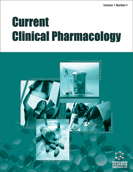Abstract
The aim of this study was to determine if Rituximab coated Biodegradable Nanoparticles (BNPs) loaded with Chlorambucil and Hydroxychloroquine could induce apoptosis of B-Chronic Lymphocytic Leukemia (B-CLL), MEC-1 and BJAB cells in vitro and evaluate their toxic and therapeutic effects on a Human/Mouse Model of Burkitt Lymphoma at an exploratory, proof of concept scale. We found that Rituximab-Chlorambucil-Hydroxychloroquine BNPs induce a decrease in cell viability of malignant B cells in a dose-dependent manner. The mediated cytotoxicity resulted from apoptosis, and was confirmed by monitoring the B-CLL cells after Annexin V/propidium iodide staining. Additional data revealed that these BNPs were non toxic for healthy animals, and had prolonged survival in this mice model of human lymphoma.
Keywords: B cells, CLL, lymphoma, nanoparticles, chlorambucil, hydroxychloroquine, rituximab.
Current Clinical Pharmacology
Title:Exploratory Study on the Effects of Biodegradable Nanoparticles with Drugs on Malignant B Cells and on a Human/Mouse Model of Burkitt Lymphoma
Volume: 5 Issue: 4
Author(s): Gustavo H. Marin, Eduardo Mansilla, Nelly Mezzaroba, Sonia Zorzet, Luis Nunez, Gustavo Larsen, Jose M. Tau, Alberto Maceira, Ruben Spretz, Carol Mertz, Sabrina Ingrao, Claudio Tripodo, Francesco Tedesco and Paolo Macor
Affiliation:
Keywords: B cells, CLL, lymphoma, nanoparticles, chlorambucil, hydroxychloroquine, rituximab.
Abstract: The aim of this study was to determine if Rituximab coated Biodegradable Nanoparticles (BNPs) loaded with Chlorambucil and Hydroxychloroquine could induce apoptosis of B-Chronic Lymphocytic Leukemia (B-CLL), MEC-1 and BJAB cells in vitro and evaluate their toxic and therapeutic effects on a Human/Mouse Model of Burkitt Lymphoma at an exploratory, proof of concept scale. We found that Rituximab-Chlorambucil-Hydroxychloroquine BNPs induce a decrease in cell viability of malignant B cells in a dose-dependent manner. The mediated cytotoxicity resulted from apoptosis, and was confirmed by monitoring the B-CLL cells after Annexin V/propidium iodide staining. Additional data revealed that these BNPs were non toxic for healthy animals, and had prolonged survival in this mice model of human lymphoma.
Export Options
About this article
Cite this article as:
H. Marin Gustavo, Mansilla Eduardo, Mezzaroba Nelly, Zorzet Sonia, Nunez Luis, Larsen Gustavo, M. Tau Jose, Maceira Alberto, Spretz Ruben, Mertz Carol, Ingrao Sabrina, Tripodo Claudio, Tedesco Francesco and Macor Paolo, Exploratory Study on the Effects of Biodegradable Nanoparticles with Drugs on Malignant B Cells and on a Human/Mouse Model of Burkitt Lymphoma, Current Clinical Pharmacology 2010; 5 (4) . https://dx.doi.org/10.2174/157488410793352058
| DOI https://dx.doi.org/10.2174/157488410793352058 |
Print ISSN 1574-8847 |
| Publisher Name Bentham Science Publisher |
Online ISSN 2212-3938 |
 11
11Related Articles
-
Extranodal Marginal Zone B-Cell Lymphoma of Mucosa Associated Lymphoid Tissue Presenting as Multiple Pulmonary Lesions: Case Report and Review of the Literature
Current Respiratory Medicine Reviews Perspective of Molecular Hydrogen in the Treatment of Sepsis
Current Pharmaceutical Design Human T-Cell Leukemia Virus Type 1: Transition from Latent Infection to Pathogenic Progression and Implications for Molecular Therapy
Current Cancer Therapy Reviews ROCK Inhibitors as Emerging Therapeutic Candidates for Sarcomas
Current Cancer Drug Targets Cytokines as Novel Therapeutic Agents for Neuroinflammatory Disorders: A Role for Interferon-β in the Treatment of Multiple Sclerosis
Current Medicinal Chemistry - Central Nervous System Agents Inhibitor at the Gates, Inhibitor in the Chamber: Allosteric and Competitive Inhibitors of the Proteasome as Prospective Drugs
Current Medicinal Chemistry - Immunology, Endocrine & Metabolic Agents Status of Anti-Lung Cancer Drug Patents Applications in China from 2003 to 2012
Recent Patents on Anti-Cancer Drug Discovery The Need for Calcium Channels in Cell Proliferation
Recent Patents on Anti-Cancer Drug Discovery Molecular Delivery of Plasmids for Genetic Vaccination
Current Pharmaceutical Biotechnology Nonstandard Drugs and Feasible New Interventions for Autoimmune Hepatitis: Part II
Inflammation & Allergy - Drug Targets (Discontinued) Tumour Re-Differentiation Effect of Retinoic Acid: A Novel Therapeutic Approach for Advanced Thyroid Cancer
Current Pharmaceutical Design Three Musketeers for Lowering Cholesterol: Statins, Ezetimibe and Evolocumab
Current Medicinal Chemistry Tobacco, Inflammation, and Respiratory Tract Cancer
Current Pharmaceutical Design Src Family Kinases: Potential Targets for the Treatment of Human Cancer and Leukemia
Current Pharmaceutical Design Integrase Strand Transfer Inhibitors and the Emergence of Immune Reconstitution Inflammatory Syndrome (IRIS)
Current HIV Research Biomarkers to Assess the Targeting of DNA Repair Pathways to Augment Tumor Response to Therapy
Current Molecular Medicine miR-15b and miR-21 as Circulating Biomarkers for Diagnosis of Glioma
Current Genomics Rational Drug Development Using Gene-Targeted Agents and Their Application in Anti-Gene Radiotherapy
Current Genomics Advances of AKT Pathway in Human Oncogenesis and as a Target for Anti-Cancer Drug Discovery
Current Cancer Drug Targets Pentacyclic Triterpenoids and Their Saponins with Apoptosis-Inducing Activity
Current Topics in Medicinal Chemistry






















